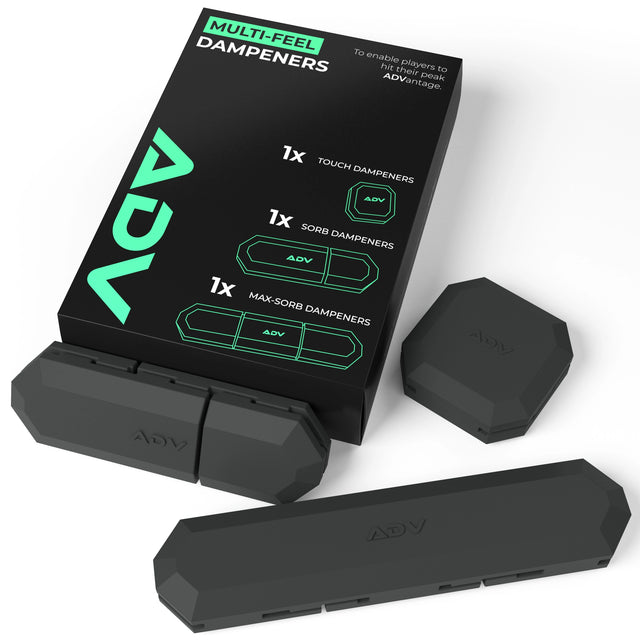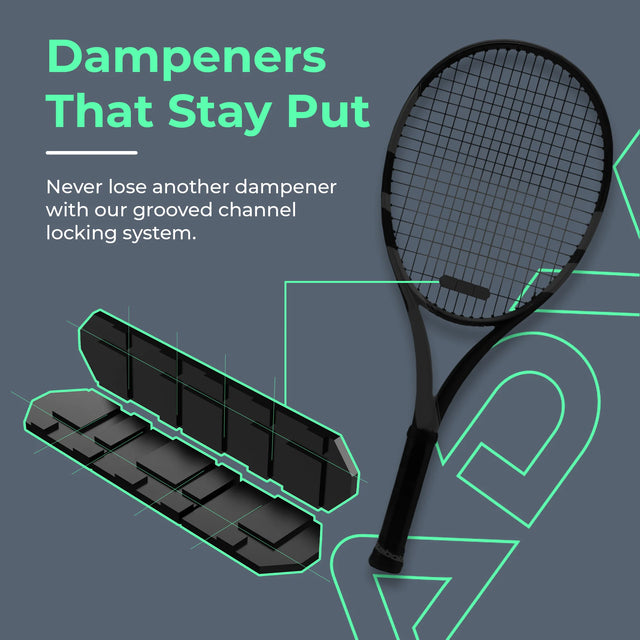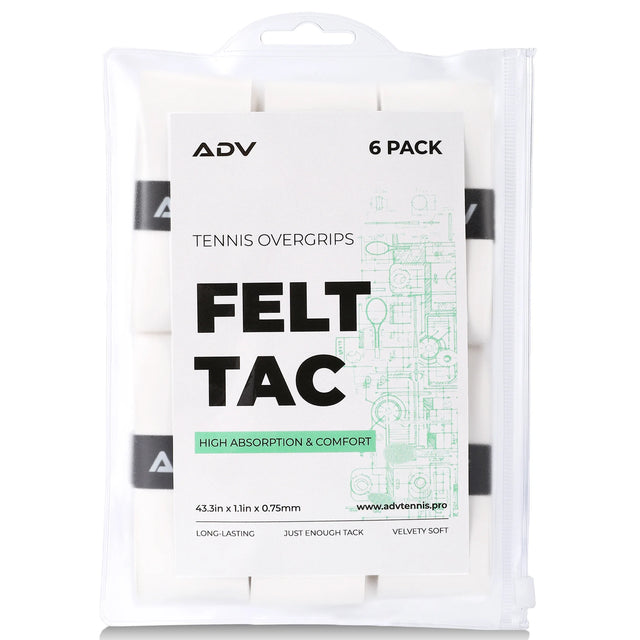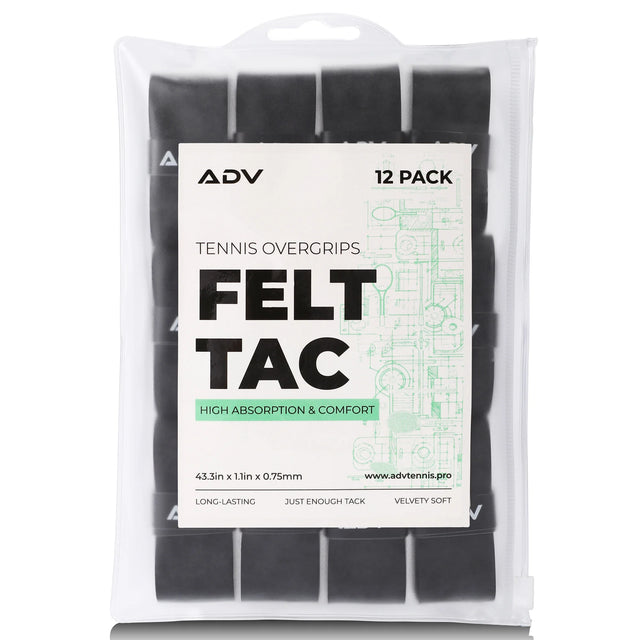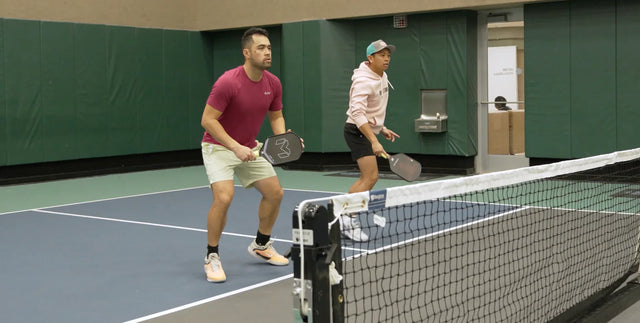Tennis Grip Types: A Complete Guide For Players Of All Levels
A tennis grip for control is fundamental to mastering the game. It serves as the primary interface between the player and the racquet, influencing every stroke. A correct grip enhances control over the ball's direction, spin, and speed, enabling players to execute their strategies effectively. For beginners and seasoned players alike, understanding and refining the grip can lead to noticeable improvements in in-game control. Moreover, a well-maintained grip ensures comfort and reduces the risk of repetitive-stress injuries to the hands and wrists.
The Evolution and History of Tennis Grips
The history of tennis grips reflects the sport’s ongoing evolution in technique, equipment, and playing surfaces. In the early days of tennis, the continental grip was the dominant choice for nearly every stroke, largely due to the prevalence of wooden racquets and grass courts, which produced lower bounces and favored flatter shots. As technology advanced, players began to seek grips that allowed for greater topspin and adaptability. The shift from predominantly grass to hard and clay courts also played a key role, as these surfaces produce higher bounces that are more effectively managed with grips like the eastern, semi-western, and western. The eastern grip gained popularity in the mid-20th century as a versatile option for both power and control, while the semi-western and western grips rose to prominence in the modern era, enabling players to generate heavy topspin and excel in baseline rallies. Today’s professionals often use modified or hybrid grips, tailoring their hand placement to suit their playing style and the demands of the game. This evolution underscores how grip choices are shaped by a combination of technological, tactical, and environmental factors, explaining the diversity and popularity of certain grips in contemporary tennis.

Understanding the Primary Tennis Grips
Forehand and Backhand Grip Variations
Tennis offers a range of grip options for forehand and backhand strokes, each designed to optimize performance for different playing styles and situations. On the forehand side, players commonly choose between the Eastern, Semi-Western, and Western grips. The Eastern forehand grip is favored for its natural feel and versatility, allowing for flat, fast shots and easy transitions between strokes, making it ideal for beginners and those who value control. The Semi-Western grip, now the most popular among advanced players, enables greater topspin and is well-suited for baseline rallies and handling higher-bouncing balls. The Western grip, considered the most extreme, shifts the hand further underneath the handle to generate maximum topspin, particularly effective on slow clay courts but demanding in terms of wrist strength and less adaptable for low balls or quick grip changes.
For backhand strokes, players can utilize either a one-handed or two-handed grip. The one-handed backhand, often using the Eastern backhand grip (with the index knuckle on the bevel one), provides extended reach and the ability to create sharp angles, though it requires significant strength and precise timing. In contrast, the two-handed backhand, where the dominant hand adopts a Continental or Eastern backhand grip and the non-dominant hand uses an Eastern or Semi-Western forehand grip, offers enhanced stability, power, and control, especially when returning high-speed balls or handling shots outside the strike zone. Each grip variation presents unique advantages, enabling players to tailor their technique to match their physical abilities and tactical preferences.
Backhand Tennis Grip Basics
This grip can be executed with one hand or two, depending on the player's strength, style, and comfort. A two-handed backhand provides more stability and control, allowing for powerful returns and increased ability to handle high-speed balls. Mastering the backhand grip is essential for a well-rounded game, as it ensures players can respond effectively to shots on any part of the court.
Grip for Serve in Tennis
Typically, players use a Continental grip for serves because it allows for a versatile range of serve types, including flat, slice, and kick serves. The positioning of the hand on the racket's handle affects the angle and speed of the serve, making it a critical skill to refine to gain an edge in matches. A well-executed serve grip can dramatically increase a player’s ability to start points under favorable conditions.
Benefits of Adjusting Grips for Different Shots
Adjusting tennis grip styles according to the shot being played is a mark of an advanced player. Such flexibility allows for optimal performance across various playing conditions. For instance, shifting from an Eastern to a Western grip can enhance topspin on forehand shots, which is particularly useful on slow clay courts. Similarly, tweaking the grip for a slice or a volley can help keep the ball low and difficult for opponents to return. Such adjustments require practice and understanding of how each grip impacts the trajectory and spin of the ball.
Exploring Different Tennis Grip Styles
Eastern Grip
The Eastern grip is a versatile and commonly used tennis grip that offers a natural racket position for straightforward swings. It is characterized by its ease of use and the ability to generate flat shots with moderate spin. To better understand the advantages and applications of the Eastern grip, consider the following key points:
-
Natural Feel: Famously likened to a handshake, the eastern grip is a familiar and instinctive action. This similarity makes it particularly appealing to beginners who are navigating the basics of tennis. Its natural orientation allows for quick mastery and reduces initial discomfort, making it a go-to option for those new to the game.
-
Flat and Precise Shots: This grip is also tailored for executing flat shots, characterized by their lower trajectory and higher speed. The Eastern grip facilitates striking the ball with minimal spin, which contributes to greater speed and precision. This makes it ideal for players looking to maintain control over their shot placement and outmaneuver opponents with swift, clean hits.
-
Transition Ease: Versatility is a cornerstone of the Eastern grip, accommodating efficient transitions between forehand and backhand strokes without the need for significant adjustments. This feature supports a fluid playing style, enabling players to respond adeptly to various shots during a match. Its adaptability is especially beneficial in fast-paced exchanges, enhancing a player's ability to switch techniques swiftly.
-
Reduced Wrist Strain: By aligning more naturally with the arm's movements, the Eastern grip minimizes stress on the wrist. This ergonomic benefit is crucial during intense and prolonged matches where repetitive motion can lead to strain and injuries. This grip is helpful to players in preserving stamina and avoiding typical wrist problems linked to more aggressive grip methods.
-
Serve and Volley: Although not predominantly used for spin-heavy serves, the Eastern grip excels in flat-serve executions. It also promotes an effective transition to volleying at the net due to its inherent stability and ease of control. Players can serve with confidence and quickly move into a net position, facilitating an aggressive and integrated approach to their play style.
Understanding the full capabilities and applications of the Eastern grip in tennis can significantly enhance a player's effectiveness on the court. By integrating this grip into their repertoire, players can leverage its benefits for a more intuitive, precise, and injury-conscious game.

Continental Grip
Often referred to as the "chopper" grip because it resembled the motion of chopping wood, the Continental grip is essential for a variety of shots, including serves, volleys, and overheads. It involves placing the base knuckle of the index finger on the bevel of one of the racket handles, which naturally positions the racket perpendicular to the ground. It is excellent for hitting slice serves that swerve away from the opponent, making it a staple for players with a strong serve-and-volley game. Its versatility makes it suitable for quick net exchanges and defensive shots.
Western Grip
Since it produces the most topspin, players who play aggressively from the baseline tend to choose the Western grip. This grip shifts the hand further beneath the handle, allowing for a more pronounced brush up against the back of the ball. The result is heavy topspin, which is particularly effective on slow clay courts where balls tend to bounce higher. The Western grip requires good wrist strength and flexibility, as it puts considerable strain on the wrist and forearm.
Hybrid Grips
Hybrid grips blend elements of traditional grip styles to suit specific playing conditions and personal preferences. Such grips are tailored to enhance both the forehand and backhand, allowing players to manipulate spin, speed, and trajectory with greater precision. For example, a combination of the Eastern forehand and Semi-Western backhand grips can accommodate a wide range of shots without significant adjustments, providing a strategic advantage in varied gameplay scenarios.
Common Mistakes and Injury Prevention
There are frequent errors players make with grips. One of the most frequent mistakes in tennis grip techniques is gripping the racket too tightly, which can lead to reduced wrist flexibility and decreased shot effectiveness. To avoid this, players should focus on maintaining a relaxed grip pressure, which enhances racket head speed and control. Another common error is using an incorrect grip size, which can strain the hand and lead to injuries.
Strengths and Weaknesses of Each Grip
Each tennis grip offers distinct advantages and disadvantages, influencing which styles and situations they best suit. The Eastern grip provides a natural feel and balanced control, making it ideal for beginners and players who favor flat, precise shots. Still, it struggles to generate heavy topspin or handle high-bouncing balls. The Continental grip excels in versatility, allowing quick transitions between serves, volleys, and slices, yet it lacks topspin and power for modern baseline rallies. The Semi-Western grip is popular among aggressive baseliners, offering excellent topspin and adaptability across surfaces. However, it can be less effective on low balls and requires more adjustment when moving to net play. The Western grip generates maximum topspin and thrives on slow, high-bouncing courts, but demands strong wrist action and makes handling low balls or rapid grip changes challenging. By understanding these strengths and weaknesses, players can select grips that align with their playing style and adapt to varying match conditions.
How to Hold and Find Each Grip
Properly holding and identifying each tennis grip begins with understanding the racket handle’s bevel, the eight flat sides that guide hand placement. To find the correct grip, start by holding the racket out in front of you with the strings perpendicular to the ground. For the continental grip, place the base knuckle of your index finger and heel pad on bevel two (right-handed players). For an eastern grip, move to bevel three; for semi-western, bevel four; and for western, bevel five. A helpful technique is to “shake hands” with the racket, naturally aligning your hand for the eastern grip, or lay your palm flat on the strings and slide it down to the handle. Ensure your hold is firm but relaxed, with your fingers wrapped comfortably and your thumb resting along the back of the handle. Practicing these steps repeatedly will help you confidently recognize and switch between grips during play.
Importance of Grip Racket Size
How to Measure Tennis Grip Size
Properly measuring your tennis racket grip size is critical for achieving optimal control and comfort while playing. The correct grip size helps prevent injuries and improves the overall effectiveness of your strokes. To determine the appropriate grip size, you can follow these steps:
-
Extend Your Playing Hand: Start by fully extending your playing hand, spreading out all fingers to their maximum length. This initial step is crucial because it sets the basis for an accurate measurement. By extending your hand, you provide a clear and unobstructed view of the palm, allowing for precise placement of the measuring tool. Proper hand extension ensures that the grip size selected will provide the best possible combination of comfort and control, optimizing your performance and reducing the chance of injury due to a mismatched grip size.
-
Align the Ruler: Place a ruler so that its end aligns with the bottom lateral crease of your palm. This alignment is critical as it establishes the starting point for your measurement. Ensuring the ruler is positioned correctly helps in obtaining an accurate measurement of the grip size. Proper alignment is vital because it guarantees that the measurements taken are reflective of the size that will best fit the anatomy of your hand, which is essential for achieving optimal control and comfort with your racket during play.
-
Measure to the Tip: Measure from the ruler's aligned end at the palm crease straight to the tip of your ring finger. This distance is what determines the ideal grip size for your tennis racket. This measurement must be accurate as it ensures that the racket will feel like an extension of your arm, enhancing your ability to play effectively. An accurate grip size is crucial for maintaining control over the racket and reducing the risk of strains or injuries, allowing you to play comfortably for longer periods.
This measurement, typically ranging from 4 inches to 4 5/8 inches, will give you a good starting point. However, it’s essential to test different sizes to find what feels most natural and comfortable, particularly under playing conditions. A racquet grip that’s too small can lead to overexertion and a loss of racket control, whereas a grip that’s too large can hinder wrist mobility and increase the risk of elbow issues.

Grip Selection and Suitability
One must learn how to choose the most appropriate grip for a player's style, level, and needs. Younger players and those with smaller hands might benefit from a smaller grip, which allows for quicker wrist movement and easier handling. In contrast, players with larger hands or those who rely on a power-based game might prefer a larger grip to ensure better stability and force in their shots. Players should consider their typical stroke mechanics and how they handle the racket during different types of shots when choosing a grip size.
Using Overgrips and Grip Tapes in Tennis
Benefits of Using Tennis Overgrips
Utilizing these is common practice among players seeking to optimize their racket handles for better performance. Overgrips provide several advantages, including improved moisture absorption, increased comfort, and enhanced grip. These thin layers wrap over the existing grip, offering a fresh surface that can reduce slippage caused by sweat during intense matches. Moreover, overgrips are available in various textures and thicknesses, allowing players to customize the feel according to their preferences and playing conditions.
Taping Tennis Racket
To start, remove the old grip or overgrip, ensuring that the handle is clean and free of residue. Begin wrapping the new grip tape at the bottom of the handle, overlapping each layer slightly as you move upwards to ensure complete coverage and a snug fit. Finish by securing the top with the adhesive strip provided with the grip tape. This refresh can significantly improve the racket’s handle feel and prevent the grip from unraveling during play.
Selecting the Best Overgrips for Tennis
Consider factors such as climate, sweat levels, and personal comfort preferences. For humid conditions or players who sweat heavily, look for overgrips that offer superior absorption qualities. Those who prefer a tackier feel might opt for grips that provide extra stickiness, enhancing the racket’s hold during swings. Additionally, players should consider the grip’s durability and how often they play, as frequent players might benefit from thicker, more durable overgrips to withstand regular use.
Maintaining and Replacing
A well-kept grip provides the necessary cushion and moisture absorption, critical during intense games. Over time, the grip's materials can degrade due to exposure to elements like sun, sweat, and dirt, losing their effectiveness. Players will notice a decrease in the grip’s tackiness, which can lead to slipping during swings, reducing precision and power. It's essential for players to regularly inspect their grips for any signs of wear, such as fraying, hardening, or smoothing of the surface, which can drastically affect their game. Replacing the grip before it completely wears down is recommended, as a fresh grip can dramatically improve the feel and handling of the racket, potentially enhancing the player's confidence and performance.
Incorporating grip maintenance into a player's routine can also provide a psychological edge. Knowing that their equipment is in excellent condition allows players to focus more on their technique and strategy rather than worrying about their racket slipping or causing discomfort. This attention to detail can be particularly advantageous in competitive settings where marginal gains can make a significant difference. Committing to regular maintenance of your tennis racket grip is essential for ensuring long-term performance and enjoyment of the game. Just as you would regularly restring your racket to maintain its tension and integrity, you should also pay attention to the condition of your grip. A well-maintained grip will prevent the racket from slipping during crucial points and reduce the risk of blisters and other hand injuries. Regularly replacing worn grips and overgrips not only keeps the racket feeling new but also provides ongoing shock absorption, which is vital for protecting your arm and wrist from repetitive stress injuries. Enhance your control, comfort, and performance on the court with premium ADV Tennis grips and accessories.


